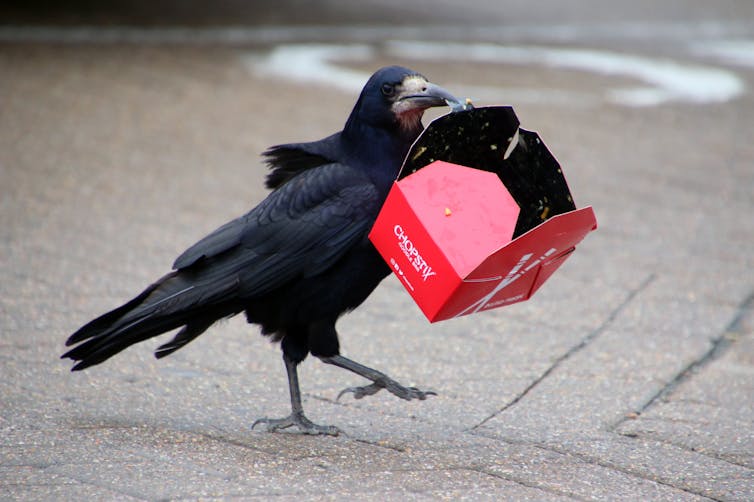Seagulls, songbirds and parrots: what new research tells us about their cognitive ability
Author: Claudia Wascher, Associate Professor in Behavioural Biology, Anglia Ruskin University
As you can imagine, a human intelligence test doesn’t really cut it for birds. It isn’t that easy to assess how an animal perceives information from the environment, processes it and decides to act. But researchers have developed a range of clever experiments to find out more about their cognitive abilities. Do they recognise each other, for example, or understand causal relationships where one thing can lead to another?
A commonly used “intelligence test” for animals is the string-pulling task . In this set-up, a piece of food is attached to a string. The food is then positioned out of reach for the animal – although still visible – and if they understand the causal relationship between the string and the food, they will start to pull the string which then moves the food closer to them until they reach it. If an animal can solve the string-pulling task we assume that it understands the relationship between the string and the reward and can deliberately execute a series of actions to get access to the reward.
In a recent study, ring-billed gulls were tested using the string-pulling model. Ring-billed gulls inhabit Canada and northern USA, however individual birds regularly wander to Western Europe and are nowadays regular visitors in Ireland and the UK.
Gulls from a colony in Canada were individually marked with a colour band. This allowed the researchers to identify individual birds, which is important when testing cognition – and is often an obstacle for research on wild animals. In the test, a transparent plastic box was presented to the gulls, and they needed to pull a string through an open slit to retrieve a piece of sausage placed in a Petri dish from inside the box. Gulls are omnivores and their diet consists of insects, fish, grain, eggs, worms and rodents. So a piece of sausage was particularly appealing.
Seabird skills
This task was given to 138 individuals at least once, and 104 individuals – 75% – of the gulls attempted to solve the task. Of these, 26 individuals – 25% of those who attempted the task at least once – successfully retrieved the food from the box by pulling the string.
That may not seem like a particularly large number of successful gulls, but in a comparable experiment in common ravens, 26% successfully solved a similar task, suggesting that ravens and gulls perform similarly well. So that one test, at least, seems to suggest that corvids might not necessarily always possess higher cognitive abilities compared to other groups of birds, as has been widely assumed.

Gulls also perform well in other recent cognitive tasks – for example, urban herring gulls use human cues, such as human handling of food or human behaviour, to make foraging decisions which exploit their city home and help them to locate hidden food for themselves.
Up until recently, groups of birds such as fowl, birds of prey or penguins were rarely subjected to cognitive tests, because they were widely considered “less clever” and therefore less interesting than the songbirds – corvids such as crows, ravens, magpies and jays – and parrots which have attracted the most interest from animal cognition experts due to what is thought to be their extraordinary cognitive abilities.
But the recent studies on gulls – and a number of other waterfowl species – have shone a light on their previously undiscovered skills. Greylag geese can memorise social relationships for at least six months, probably longer. And domestic chickens can learn to differentiate between a rewarded and unrewarded colour as quickly as carrion crows.

Corvids and parrots still impress
So it seems that corvids and parrots are not the only birds who show evidence of their brain power, and perhaps we should reconsider the use of the insult “bird brain”. But none of that detracts from the marvellous feats we witness in some of those more famous bird families. Earlier this year in Sydney, wild urban-dwelling sulphur-crested cockatoos not only learned to open wheelie bins and get food from them, but individuals also learned to do this from each other – it became a cultural innovation.
Other recent studies have shown that New Caledonian and Hawaiian crow are among only a handful of animal species who can make and use tools. And, in a food hoarding experiment, scrub-jays demonstrated what-where-when memory: they seemed to remember what type of food they had hoarded at specific locations, and when they had done it. In the more barren winter months, this helps them to remember where they have hidden food which they have gathered and stored for later consumption.
Crows, ravens and goffin cockatoos dislike when they are treated unfairly and have been observed to wait for several minutes to receive a better food reward. Rooks, meanwhile, and blue‐throated macaws can cooperate with other individuals to together solve a string-pulling task.
It’s clear that cognitive abilities are important for animals to cope with all sorts of challenges in their environment. Therefore, understanding how they think can bring many valuable benefits. If we know how animals learn about predators, for example, it can help us to design more effective re-introduction programmes to conserve biodiversity.
And if we can assess whether an animal in a zoo, farm or kennel is feeling well or suffering, we can work to improve their living conditions and perhaps even control unwanted behaviour, such as those displayed by pets or in human-wildlife conflicts.![]()
This article is republished from The Conversation under a Creative Commons license. Original article.